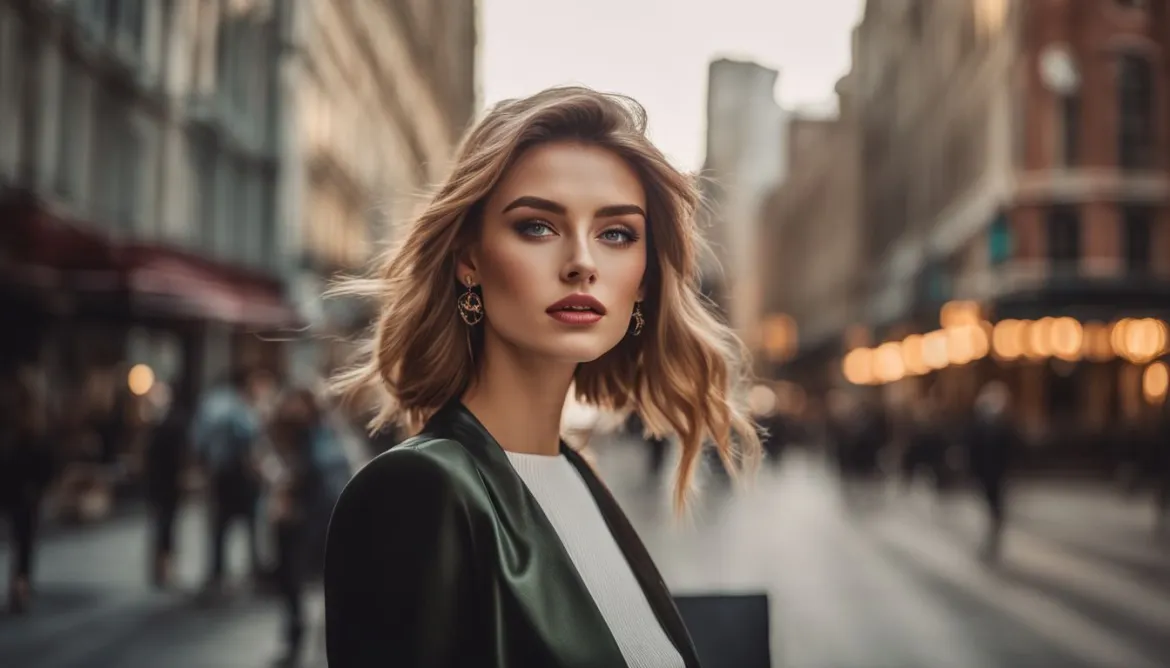Getting your fashion photography published can be an exciting opportunity to showcase your talent and establish yourself in the industry. By following a few essential tips and understanding the ins and outs of the submission process, you can increase your chances of getting published in top fashion magazines.
In this article, we will provide you with valuable insights, practical advice, and industry guidelines to help you navigate the world of fashion photography submissions with confidence. Whether you’re a budding fashion photographer or an experienced professional looking to elevate your career, these tips will help you create a strategy for successful publication.
Key Takeaways:
- Understand your brand identity and visual style to align your work with the right publications.
- Thoroughly research magazines that resonate with your photography style and target audience.
- Follow submission guidelines and tailor your submissions to fit specific themes.
- Confidently pitch your work, showcasing why it’s a good fit for the magazine.
- Submit your work professionally, adhering to file size requirements and proper submission processes.
Understand Your Brand Identity and Visual Style
Before submitting your fashion photography to magazines, it’s crucial to grasp the essence of your brand identity and visual style. By taking the time to contemplate the type of fashion photography you specialize in, the distinctive themes that resonate in your work, and the message you intend to convey, you can align your submissions with magazines that complement your aesthetic. This alignment will significantly enhance your chances of getting published.
Reflection on Brand Identity
Branding is vital in the fashion industry, as it helps you stand out and establish a unique identity. Reflect on the following questions to shape your understanding of your brand:
- What are the core values, characteristics, and personality traits that define your brand?
- What makes your fashion photography distinguishable from others?
- What emotions or moods do you want your work to evoke?
Consider these aspects when selecting magazines to submit to, as finding ones that share your brand identity will strengthen the alignment between your portfolio and the publication’s audience.
Visual Style Assessment
Your visual style is the artistic expression of your brand. Analyze the following factors to better comprehend your visual style:
- What lighting techniques do you employ in your photographs?
- Are there specific compositions or framing techniques you consistently use?
- What color palettes and tones recur in your work?
Understanding your visual style allows you to target magazines that resonate with your artistic choices. It enables you to select publications that appreciate and value your unique aesthetic vision, increasing the likelihood of acceptance and publication.
Remember, brand identity and visual style are essential foundations for establishing your presence in the fashion photography industry.
| Brand Identity | Visual Style |
|---|---|
| Defines your brand values, characteristics, and personality traits | Expresses your artistic choices, lighting techniques, compositions, color palettes |
| Helps align your submissions with magazines sharing your aesthetic | Enables you to target publications that appreciate your unique visual style |
| Increases chances of getting published | Enhances resonance and acceptance by the target audience |
Research and Find the Right Publications
Researching and finding the right publications is a crucial step towards getting your fashion photography published. By targeting the right magazines, you can ensure that your work aligns with their style and reaches your intended audience. Here are some key factors to consider:
- Fashion Magazine Research: Conduct thorough research on different fashion magazines to understand their aesthetic, themes, and content. Look for magazines that resonate with your visual style and brand identity.
- Magazines with Similar Style: Identify magazines that share a similar visual aesthetic to your fashion photography. When your work aligns with a magazine’s style, it increases the likelihood of your submissions being accepted.
- Target Audience: Consider the target audience of each publication. Look for magazines that cater to the demographic you want to reach, as this will help you connect with the right readers and potential clients.
- Submission-Based Magazines: Focus on submission-based magazines that openly provide guidelines and requirements on their websites. These magazines actively seek new content and are more likely to consider your fashion photography.
- Magazine Contacts: Build a comprehensive list of editorial contacts for the magazines you are interested in. Having direct contacts will enable you to establish a personal connection and increase your chance of getting noticed.
By conducting in-depth fashion magazine research, identifying magazines with similar style, and understanding the preferences of your target audience, you can strategically approach the right publications for your fashion photography submissions. Building strong connections with industry contacts will further enhance your chances of success.

Quote: “Researching the right publications is like finding the perfect runway for your fashion photography to shine. By targeting magazines that align with your style and audience, you’re one step closer to successful publication.” – Fashion Photographer
Follow Submission Guidelines and Themes
Once you’ve identified the magazines you want to submit your work to, it’s important to carefully read and follow their submission guidelines. These guidelines provide vital information on file formatting, specific themes, and how to submit wardrobe or clothing credits.
Submission guidelines vary among magazines, so it’s crucial to review them thoroughly before sending your work. Pay attention to details such as file size limits, preferred file formats, and instructions for submission. This attention to detail demonstrates your professionalism and increases the chances of your work being considered.
Some magazines also have specific themes or concepts for each issue. This is an excellent opportunity to tailor your submissions accordingly. Pay attention to any submission themes listed on the magazine’s website or social media. Aligning your work with the magazine’s theme shows your understanding of their content and increases the likelihood of acceptance.
When emailing your work to magazine editors, it’s essential to keep your content clear and to the point. Be concise and provide all necessary information without overwhelming the recipient. Whether you are submitting your work, pitching ideas, or seeking to be commissioned, address your intentions clearly in the email subject line and body.
“I’ve found that emails with a clear subject line and concise content tend to be more effective in catching an editor’s attention. Keep your email professional, yet friendly, and make sure to highlight what makes your work unique or relevant to their publication.”
Remember, each magazine may have its own preferences for email content, so always consult their submission guidelines for any specific instructions or requirements.
Pitch Your Work with Confidence
Pitching your work to fashion magazines can be a nerve-wracking experience. However, it’s essential to have confidence in what you’re selling. When approaching editors or decision-makers, take the time to understand their preferences and tailor your pitch accordingly. By demonstrating a clear understanding of the publication’s style and audience, you can increase your chances of success.
Remember, a well-crafted pitch is your opportunity to showcase why your work is a perfect fit for the magazine. Be clear, concise, and polite in your email. Highlight the unique qualities of your work and how it aligns with the magazine’s aesthetic. Personalize your pitches to show that you have done your research and genuinely appreciate their publication.
Here are some tips to help you pitch your work with confidence:
- Research the editor: Take the time to understand the editor’s background and the type of work they prefer. This knowledge will help you customize your pitch and increase your chances of getting noticed.
- Be clear and concise: Editors receive numerous pitches daily, so it’s crucial to grab their attention quickly. Keep your email concise and to the point, highlighting the unique aspects of your work in a clear and engaging manner.
- Highlight the relevance: Clearly explain why your work is relevant to their publication and how it can resonate with their audience. Emphasize the unique perspective or fresh approach your work brings to the table.
- Show your value: Articulate the value your work can bring to the magazine. Whether it’s attracting new readers, enhancing their brand image, or addressing a specific theme or trend, make it clear why your work deserves their consideration.
Pitching your work is a skill that improves with practice. Don’t be discouraged by rejections. Instead, view them as opportunities to learn and refine your approach. By continuously honing your pitching skills and staying confident in your work, you’ll increase your chances of getting your fashion photography published in top magazines.
Submit Your Work Professionally
When it comes to submitting your fashion photography, professionalism is key. Paying attention to details and following proper submission protocols will greatly increase your chances of success. Here are some essential tips to help you submit your work professionally:
- Be mindful of file sizes: Ensure that your high-resolution files are optimized for submission. Large file sizes can make it difficult for editors to download and review your work efficiently. Compress your images while maintaining quality to reduce file sizes.
- Use file sharing services: To submit your photography, consider using reputable file sharing services like WeTransfer or Dropbox. These platforms allow you to easily upload and share large files with the magazine’s editorial team.
- Follow the submission process: Each magazine may have specific guidelines and requirements for submitting fashion photography. Take the time to familiarize yourself with the submission process outlined on their website or in their submission guidelines. Adhering to these guidelines demonstrates your professionalism and respect for the publication.
- Submit within specified guidelines: Pay close attention to submission deadlines, file formats, and any additional information requested by the magazine. Missing deadlines or submitting work that does not meet the specified criteria may negatively impact your chances of getting published.
By submitting your work professionally, you show editors that you take your craft seriously and respect their time and guidelines. This increases the likelihood of your work being considered for publication. Be attentive to the details and make a positive impression from the moment you submit your fashion photography.
| Advantages of Professional Submission |
|---|
| Increased likelihood of being considered for publication |
| Respect for the magazine’s guidelines and processes |
| Efficient file sizes for easy review and download |
| Demonstration of professionalism and commitment |

Start with Smaller Publications and Build Your Way Up
When it comes to getting your fashion photography published, it’s essential to take a ladder approach. Starting with smaller publications can be the key to building a successful career in the industry. Think of these smaller publications as the first rungs on the ladder, leading you towards larger and more prestigious opportunities.
By submitting your work to smaller publications, you have a higher chance of getting accepted and gaining valuable industry experience. These publications are often more open to showcasing emerging talent and innovative styles.
One of the significant benefits of starting with smaller publications is the opportunity to build your portfolio. Tear-sheets from these publications are valuable additions to your body of work and can impress editors at larger magazines. These tear-sheets demonstrate that your work has been recognized and published, showcasing your skills and creativity.
Additionally, starting with smaller publications allows you to test out new techniques and collaborate with various creative teams. This experimentation can help you refine your style, expand your network, and learn from industry professionals.
As you grow and gain more experience, it’s important to maintain a humble attitude and focus on developing your skills and reputation in the industry. The credibility and recognition you build through smaller publications will pave the way for opportunities with major fashion magazines.
Benefits of Starting with Smaller Publications:
- Higher acceptance rates and opportunity to gain industry experience
- Build your portfolio with tear-sheets and showcase your work
- Test new techniques and collaborate with diverse creative teams
- Develop your skills and reputation in the industry
- Pave the way for opportunities with larger fashion magazines
Case Study: Rising Through the Ranks
Let’s take a look at the journey of fashion photographer Sofia Roberts. After completing her photography education, Sofia decided to start by submitting her work to smaller publications. She reached out to local magazines, online platforms, and up-and-coming fashion blogs.
“Starting with smaller publications allowed me to gain invaluable experience in the industry. I learned how to work with different creative teams, adapt to various styles, and meet tight deadlines. Each publication that featured my work added credibility to my portfolio and gave me the confidence to aim higher.”
– Sofia Roberts, Fashion Photographer
Sofia’s persistence and dedication paid off, and she soon started receiving tear-sheets from these smaller publications. These tear-sheets not only showcased her work but also served as proof of her talent and gave her an edge in the competitive industry.
With her growing reputation and portfolio, Sofia set her sights on larger publications. Armed with tear-sheets, industry experience, and refined skills, she approached mid-sized fashion magazines. As her work began to appear in these publications, Sofia’s name started gaining recognition in the industry.
Eventually, Sofia’s talent and hard work opened doors for her at major fashion magazines. Her ladder approach, starting with smaller publications and gradually working her way up, allowed her to establish herself as a successful fashion photographer admired by editors and industry professionals.
| Stage | Publication | Achievement |
|---|---|---|
| First | Local Fashion Magazine | Featured in a 4-page spread |
| Second | Online Fashion Blog | Regular contributor on fashion trends |
| Third | Regional Lifestyle Magazine | Awarded “Emerging Photographer of the Year” |
| Fourth | National Fashion Magazine | Published cover story with a celebrity |
Conclusion
Getting your fashion photography published is a key milestone in achieving success in the industry. It offers a valuable opportunity to showcase your work, gain recognition, and establish yourself as a professional fashion photographer. By following the steps outlined in this article, you can increase your chances of getting published in fashion magazines and open doors to exciting new opportunities.
Understanding your brand identity and visual style is the first step towards creating a cohesive and compelling portfolio that resonates with editors and readers. Researching and finding the right publications that align with your aesthetic and target audience is crucial for a successful submission. By carefully reading and adhering to submission guidelines, you demonstrate your professionalism and respect for the publication’s requirements.
Confidently pitching your work, tailored to the editor’s preferences, plays a vital role in capturing their attention and generating interest. Professionalism is key when submitting your work, ensuring high-quality files are shared through appropriate file sharing services. Starting small and gradually building your way up the ladder of publications allows you to gain experience, refine your skills, and establish a solid reputation within the industry.
With persistence, dedication, and continuous improvement, you can achieve your goal of getting your fashion photography published in top magazines. Embrace industry insights, seek feedback, and stay true to your unique brand identity. By implementing these strategies, you can pave your way to success and make a lasting impact in the world of fashion photography.
FAQ
How can I get my fashion photography published?
To get your fashion photography published, you can start by understanding your brand identity and visual style. Research and find the right publications that align with your aesthetic and cater to your target audience. Follow the submission guidelines and themes of the magazines you are interested in. Pitch your work with confidence, addressing the editor’s preferences and showcasing why your work is a good fit. Submit your work professionally, following the guidelines and using file sharing services for high-resolution files. Start with smaller publications and gradually work your way up to larger ones.
Why is understanding my brand identity and visual style important?
Understanding your brand identity and visual style helps you tailor your submissions to magazines that align with your aesthetic. It allows you to showcase your unique perspective and message through your fashion photography and increases your chances of getting published in magazines that resonate with your style.
How can I research and find the right publications for my fashion photography?
Researching and finding the right publications involves looking for magazines that have a similar visual aesthetic to yours and cater to your target audience. Consider both print and digital publications and focus on submission-based magazines that list their guidelines and requirements on their website. Building a list of prospective editorial contacts and understanding the themes and preferences of each magazine will greatly increase your chances of success.
What should I do to successfully follow submission guidelines and themes?
To follow submission guidelines and themes, carefully read and understand the guidelines provided by the magazine. Pay attention to file formatting, specific themes, and wardrobe or clothing credit requirements. Tailor your submissions accordingly and address whether you are submitting, pitching ideas, or looking to be commissioned. Keep your content clear and to the point when emailing your work, and personalize your pitches to show that you understand and appreciate the publication’s style and audience.
How can I pitch my work with confidence?
To pitch your work with confidence, take the time to understand the editor or decision-maker you’re pitching to and tailor your pitch accordingly. Be clear, concise, and polite in your email, highlighting why your work is a good fit for the magazine. Personalize your pitches and show that you understand and appreciate the publication’s style and audience. Having confidence in your work and its relevance to the magazine increases your chances of capturing the editor’s attention.
How can I submit my work professionally?
To submit your work professionally, be mindful of file sizes and use file sharing services like WeTransfer or Dropbox for high-resolution files. Follow the submission process outlined by the magazine, ensuring that you send in your work within the specified guidelines. Taking these steps shows your professionalism and increases the likelihood of your work being considered for publication.
Why should I start with smaller publications and build my way up?
Starting with smaller publications allows you to gain experience, build your portfolio with tear-sheets, and test out new techniques and creative teams. It helps you develop your skills and reputation in the industry gradually. The ladder approach allows you to learn, grow, and refine your work along the way, increasing your chances of getting published in larger publications as you progress.
How can I achieve success in getting my fashion photography published?
To achieve success in getting your fashion photography published, it’s crucial to understand your brand identity, research and find the right publications, follow submission guidelines and themes, pitch your work with confidence, submit professionally, and start with smaller publications to build your way up. Persistence, dedication, and continuous improvement are key to gaining recognition and getting published in fashion magazines.
How Can I Ensure my Fashion Photography Gets Successfully Published While Navigating Copyrights and Model Releases?
When it comes to ensuring your fashion photography gets successfully published, navigating copyrights and model releases is crucial. Make sure to obtain the proper legal permissions and releases before submitting any work for publication. It’s essential to protect your work and the rights of the models involved.
Source Links
- https://www.jamielynncheeks.com/blog/2023/9/1/10-tips-for-getting-published-on-a-fashion-editorial-magazine
- https://www.larajadeeducation.com/blogposts/top-tips-for-submitting-your-work-to-fashion-magazines
- https://colesclassroom.com/the-one-step-that-really-helps-getting-photos-published-secrets-from-a-former-magazine-manager/




